Dendera
Dendera (Arabic: دندرة Dandarah; Ancient Greek: Τεντυρις or Τεντυρα; Coptic: ⲧⲉⲛⲧⲱⲣⲉ or ⲧⲉⲛⲧⲱⲣⲓ),[1][2] also spelled Denderah, ancient Iunet,[3] Tentyris[4][5] or Tentyra[6] is a small town and former bishopric in Egypt situated on the west bank of the Nile, about 5 kilometres (3 mi) south of Qena, on the opposite side of the river. It is located approximately 60 kilometres (37 mi) north of Luxor and remains a Latin Catholic titular see. It contains the Dendera Temple complex, one of the best-preserved temple sites from ancient Upper Egypt.
Dendera ⲧⲉⲛⲧⲱⲣⲉ ⲧⲉⲛⲧⲱⲣⲓ دندرة | |
|---|---|
City | |
 Clockwise from top: Entrance to Dendara Temple, Dendara Temple Complex, Inside Hathor Temple, Hathor Temple Complex | |
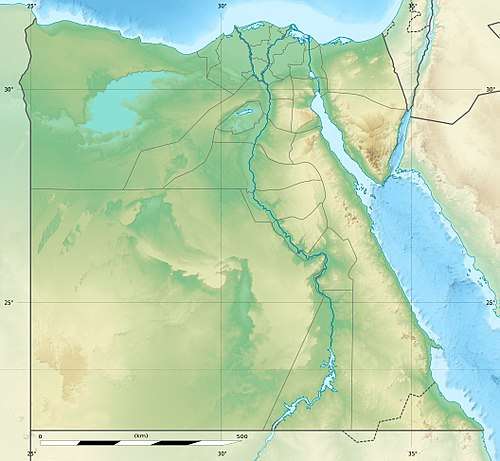 Dendera Location in Egypt | |
| Coordinates: 26°10′N 32°39′E | |
| Country | |
| Governorate | Qena |
| Time zone | UTC+2 (EST) |
History
| tꜣ n tꜣrr(t)[1][7] in hieroglyphs |
|---|
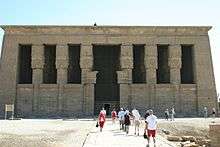

At a rather isolated place at the edge of the desert, about 2.5 kilometres (1.6 mi) south-west of the modern town, lies what Dendera is famous for, a mostly Greco-Roman temple complex known in ancient Egyptian as Iunet or Tantere. The modern Arab town is built on the ancient site of Ta-ynt-netert, which means 'She of the Divine Pillar.' In the Greek era, the town was known as Tentyra. It was once the -modest- capital of the 6th Nome (Pharaonic province) of Upper Egypt, and was also called Nikentori or Nitentori, which means 'willow wood' or 'willow earth'. Some scholars believe the name derives from the sky and fertility goddess Hathor, also associated with the Greek Aphrodite, who was especially worshiped there. The official deity of the city was a crocodile. Crocodiles were also venerated as deities in other Egyptian cities, which gave rise to many quarrels, notably with Ombos.
Ecclesiastical history
After Egypt became a Roman possession, the city of Tentyris was part of the Late Roman province of Thebais Secunda. Its bishopric was a suffragan of Ptolemais Hermiou, the capital and metropolitan see of the province. Little is known of the history of Christianity in the place, as only the names of two ancient bishops are given:
- Pachymius (Pachomius), a companion of Melece at the beginning of the fourth century
- Serapion or Aprion, a contemporary and friend of the monk St. Pachomius, whose diocese boasted the celebrated convent of Tabennisi.
The town was given its present Arabic name of Denderah during the late Ottoman Empire and ruled 6000 inhabitants in Qena (Qeneh) district.
Titular see
Under the Latin name Tentyris, the episcopal see was nominally revived as a titular bishopric (in Curiate Italian repeatedly renamed) since 1902, but is vacant since 1972,[8] having had the following incumbents of the fitting episcopal (lowest) rank :
- Matteo Gaughren, Missionary Oblates of Mary Immaculate (O.M.I.) (1902.01.13 – 1914.05.30)
- Emile-Marie Bunoz, O.M.I. (1917.06.13 – 1945.06.03)
- André van den Bronk, Society of African Missions (S.M.A.) (1946.07.30 – 1952.05.15)
- Teodoro Bensch (1956.12.01 – 1958.01.07)
- Jean-Rosière-Eugène Arnaud, Paris Foreign Missions Society (M.E.P.) (1958.03.02 – 1972.09.11).
Temple complex
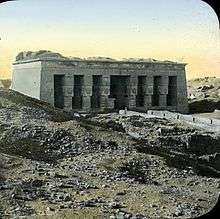
The Dendera Temple complex, which contains the Temple of Hathor, is one of the best-preserved temples, if not the best-preserved one, in all of Upper Egypt. The whole complex covers some 40,000 square meters and is surrounded by a hefty mud brick wall. The present Temple of Hathor dates back to July 54 BC, at the time of Ptolemy XII of the Ptolemaic dynasty,[9] and was completed by the Roman emperor Tiberius, but it rests on the foundations of earlier buildings dating back at least as far as Khufu (known as the Great Pyramid builder Cheops, the second Pharaoh of the 4th dynasty [c. 2613–c. 2494 BC]) but it was the pharao Pepi I Meryre who built the temple.[9][10]
It was once home to the celebrated Dendera zodiac, which is now displayed in the Louvre Museum in Paris. There are also Roman and pharaonic Mammisi (birth houses), ruins of a Coptic church and a small chapel dedicated to Isis, dating to the Roman or the Ptolemaic epoch. The area around the temple has been extensively landscaped and now has a modern visitor centre, bazaar and small cafeteria.
Climate
This area has a large amount of sunshine year round due to its stable descending air and high pressure. According to the Köppen climate classification system, Dendera has a hot desert climate, abbreviated "BWh" on climate maps.[11]
Sponsors
Monuments
References – Notes
- Gauthier, Henri (1929). Dictionnaire des Noms Géographiques Contenus dans les Textes Hiéroglyphiques Vol. 6. p. 23.
- "Tentyris (Dendera)". Trismegistos. Retrieved 29 March 2020.
- Philae-Data. "Iunet (Dendera)". ancientworlds.net. Archived from the original on 2008-05-17.
- "Linguistic Bibliography". blonline.nl.
- "Félix Teynard - Dendérah (Tentyris), Temple d'Athôr - Face Postérieure - Cléopatre et Cæsarion - The Metropolitan Museum of Art". metmuseum.org.
- In old sources such as Belzoni.
- Wallis Budge, E. A. (1920). An Egyptian hieroglyphic dictionary: with an index of English words, king list and geological list with indexes, list of hieroglyphic characters, coptic and semitic alphabets, etc. Vol II. John Murray. p. 1051.
- Tentyris at catholic-hierarchy.org.
- Bard, Kathryn A. (2005). Encyclopedia of the Archaeology of Ancient Egypt. Routledge. p. 252. ISBN 978-1-134-66525-9.
- Beaumont, Hervé (2001-02-02). Egypte: le guide des civilisations égyptiennes, des pharaons à l'islam (in French). Editions Marcus. ISBN 9782713101687.
- "Dandara, Egypt Köpen Climate Classification (Weatherbase)". Weatherbase.
- mondial, UNESCO Centre du patrimoine. "Pharaonic temples in Upper Egypt from the Ptolemaic and Roman periods - UNESCO World Heritage Centre". UNESCO Centre du patrimoine mondial (in French).
- mondial, UNESCO Centre du patrimoine. "Pharaonic temples in Upper Egypt from the Ptolemaic and Roman periods - UNESCO World Heritage Centre". UNESCO Centre du patrimoine mondial (in French).
- "Trajan was, in fact, quite active in Egypt. Separate scenes of Domitian and Trajan making offerings to the gods appear on reliefs on the propylon of the Temple of Hathor at Dendera. There are cartouches of Domitian and Trajan on the column shafts of the Temple of Knum at Esna, and on the exterior a frieze text mentions Domitian, Trajan, and Hadrian" Stadter, Philip A.; Stockt, L. Van der (2002). Sage and Emperor: Plutarch, Greek Intellectuals, and Roman Power in the Time of Trajan (98-117 A.D.). Leuven University Press. p. 75. ISBN 978-90-5867-239-1.
Sources and external links
| Wikimedia Commons has media related to Dendera. |
| Wikisource has the text of the 1911 Encyclopædia Britannica article Dendera. |

- GigaCatholic, listing the titular bishops
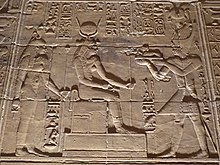
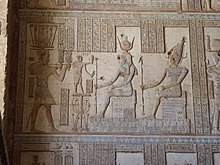



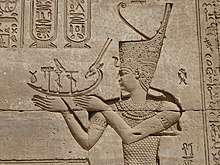
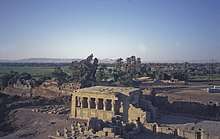

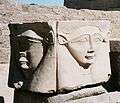
.jpg)
